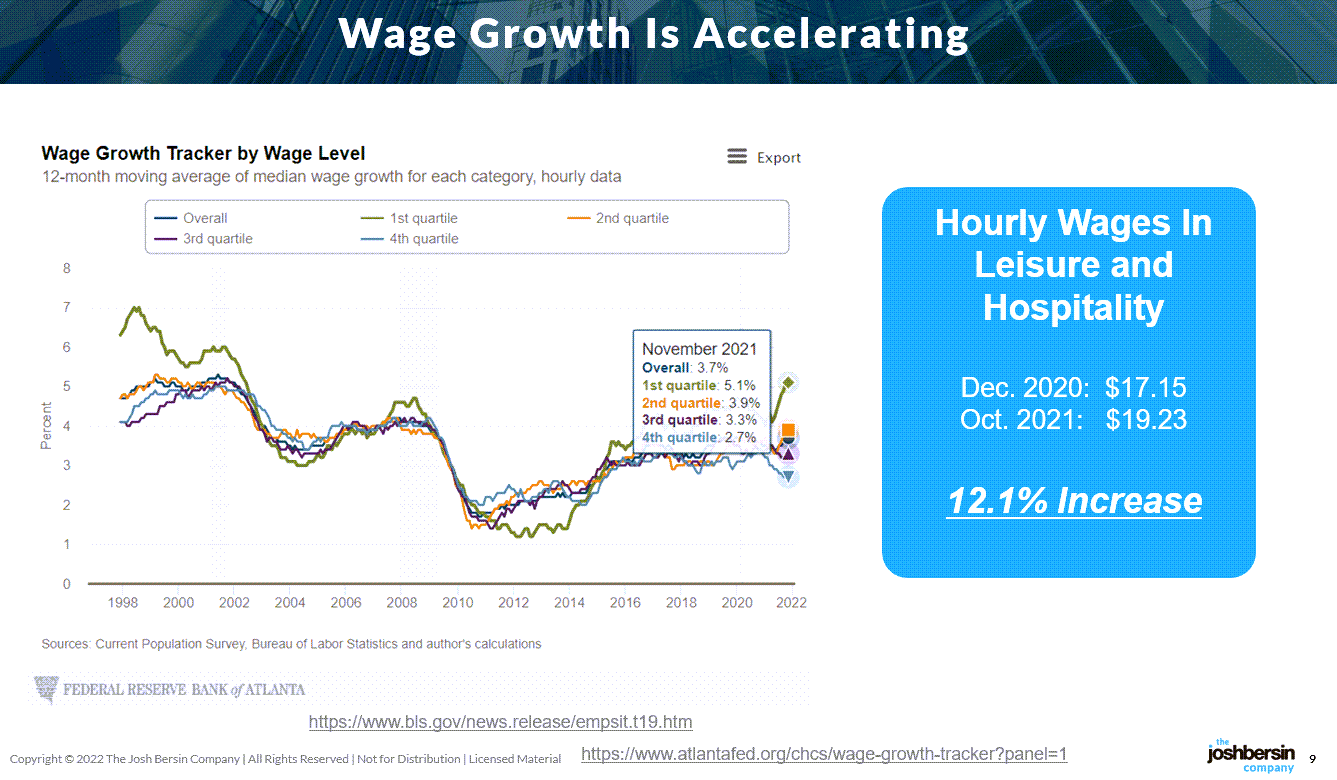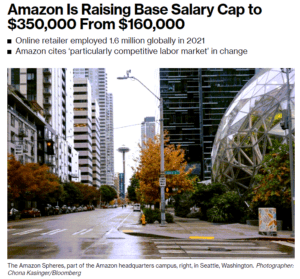From The Great Resignation To The Great Inflation. It’s Time To Get Creative.
This month we learned that the US inflation rate is over 7.5%, the US economy is growing at over 5.5%, and more than 460,000 jobs were created in January alone. The global economy is growing at a record rate and companies are finding it harder and harder to hire.
We’ve gone from “The Great Resignation” to “The Great Migration” to now “The Great Inflation.”
Yesterday we had a call with 30 heads of recruiting for some of the world’s biggest companies and I saw a sense of desperation in their eyes. Every company, from Marriott to GM to IBM, is looking at every possible way to better source, recruit, and hire the staff they need.
This is not your typical labor market cycle, it’s very different this time. There are more than 12 million US jobs open, the labor participation rate remains depressed, and younger workers are simply not willing to engage with employers unless the job feels meaningful, well-paid, and safe. Nurses and other healthcare professionals are disengaging at high rates, creating a new feeling of desperation among many of the companies we meet.
What happens when things get tough like this? Companies get creative. And that’s what’s going on.
1/ Wages Are Going Up. Deal With It.
The first solution is to raise wages. There is an old economic theory that “wages are sticky.” In other words, it’s easy to lower wages but hard to raise them (employers are afraid of committing to the increase). Well, right now this simply isn’t possible. The labor market is a “market” and employees will not come work for you if your overall EVP (employment value proposition) is not strong enough.
We know from our research that wages are not the only reason someone takes a job. In fact, growth, culture, and team fit are far bigger drivers of job satisfaction. But today, in a market where people are worried about inflation, you simply have to adapt. So don’t be afraid to make adjustments.
 |
2/ Workers Now Expect More. Pay Attention.
The second big effect of inflation is job seeker expectations. Yes, many workers are fed up with their jobs and want to find something better. But as the news media hypes the inflation cycle, people get more nervous. Inflation, as I described in an earlier article, creates a sense of uncertainty. If we think the cost of food, energy, vacation, and everything else is going up, we look for a sense of stability. So you, as an employer, have to promote and market a sense of optimism.
There is a trend, for example, towards boomerang employees. These are people who quit at one point and then decided to come back. New data from LinkedIn shows that 4.5% of all hires are boomerangs (up 30%), creating demand for alumni networks. Vendors like Enterprise Alumni tell me their clients are building highly engaging “alumni networks” to keep people connected to their company. (Ford recruited lots of retired engineers over the last few years). These are people who know your company and they want stability.
You should promote your company’s stability, benefits, profit-sharing, and 401k programs. These mean a lot to people when they see the world changing too fast.
3/ Internal Mobility Is A Secret Weapon. Invest.
The third “fix” to the inflationary job market is internal mobility. Yesterday I talked with a large business in Europe who is moving from IT services to cloud engineering and cloud application development. This new business is growing at over 50% annually. Yet they are having a terrible time sourcing and hiring the staff they need.
The solution has become clear: they have to make sure they don’t lose the people they have, and they need a fairly radical focus on building the cloud skills internally. Next month we’re launching our Global Workforce Intelligence research and what you’re going to see is that every industry (not just IT) has a new set of career pathways to build. If you aren’t investing in this strategy you’ll never hire fast enough to adapt.
One reason I know this is urgent is the data we’ve seen in corporate L&D. Our upcoming research on corporate training shows a massive focus on capability academies, learning in the flow of work, and ever-more agile career and mobility programs. Yesterday we talked with MetLife, who just unleashed its new internal career system, and they told us it took off like a rocket.
4/ Get Creative About Hiring. Lots Of Options.
The fourth solution is to rethink how you hire. Not only are college degrees dropping in value as recruiting tools (a new study by HBS shows almost 20%+ reduction in college degree requirements for hiring), companies are getting creative about assessing fit.
A comparison of Accenture’s IT hiring profile in 2021 vs. 2017 reflects how even a company that was already ahead of its peers can continue to make substantial progress, with the share of postings specifying a BA or higher down to 43% in 2021 from 54% in 2017. These reductions have borne out across 71% of the firm’s IT roles.
But we can be much more creative than dropping degree requirements. The big shift in recruiting is a focus on “fit” not “pedigree.” In other words, it doesn’t matter what school you went to or what jobs you’ve had, do you have the skills, ambition, interest, and personality match with the team? These latter “non-pedigree” factors are the ones that drive success.
One way to fix this is to stop recruiting candidates to specific jobs. Rather, you recruit by “group,” and if the person fits the functional area the precise job can be decided later. Two of the companies in our group talked about how they recruit by “job family” or “persona.” They interview and assess people for culture fit, skills and capabilities, ambition, and interest in the company’s mission. They don’t necessarily tell the candidate precisely what position they would have. Then, once the candidate is vetted and hired, the team finds the “perfect role” in the company.
While this may sound odd, it’s far more powerful than you think. It’s more like a basketball or baseball team hiring “great talent,” and deciding later which position they will play. I interviewed Epic Software (one of the world’s most successful software companies) and they recruit all positions in only seven job clusters. If you fit into their culture and have the right education and background, the actual “job” you take is determined weeks after you start.
5/ Invest In Talent Intelligence. Get Smarter.
 Finally, as we discussed this week, it’s important to get smarter about the job market as a whole. Inflation is forcing job seekers to be pickier, which in turn makes it even more important for you to know precisely what will work. Companies like Amazon have been experimenting with bonuses and education benefits, but last week capitulated and simply relaxed its policy to pay people more money.
Finally, as we discussed this week, it’s important to get smarter about the job market as a whole. Inflation is forcing job seekers to be pickier, which in turn makes it even more important for you to know precisely what will work. Companies like Amazon have been experimenting with bonuses and education benefits, but last week capitulated and simply relaxed its policy to pay people more money.
If they had studied this problem in advance, I suggest this wouldn’t have been necessary. I have been talking with Amazon professionals who wanted to leave for several years (many leave when their stock grants are vested). Employers should conduct a conjoint analysis (a process where employees rank their benefits fairly and you can see what they really find valuable) and study what’s driving retention.
If you don’t have good data about why people leave, why they stay, and what they want next … well, it’s your own fault. This kind of information is important. It tells you how to pinpoint the investments you make in people. It always struck me funny that companies invest hundreds of millions of dollars in customer and consumer research, but almost nothing in research about their employees and the labor market. It’s time to turn this around.
6/ Don’t Let Inflation Make You Crazy. Be Creative.
Finally, you have to accept the fact that dealing with inflation is now part of your job. In the 1970s (I remember when inflation was over 12%) companies offered lots of upgraded benefits, career development, loans, and other solutions. You should do the same.
In only two years we’ve gone from The Great Resignation to The Great Migration to The Great Inflation. While costs may go up, so will revenues. Now is a time look carefully at every people practice you have. We are entering one of the most creative and innovative times I’ve seen in HR. Let’s strap in and go along for the ride.
Additional Resources
Secrets To Recruiting In A Crazy Labor Market: On-Demand Pay And More


